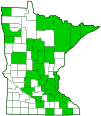spider wasp
(family Pompilidae)
Overview • Description • Distribution • Taxonomy
Description |
||
Most spider wasps are slender and black or dark blue, sometimes metallic. Wasps have a three-segmented thorax. On spider wasps the third segment is solidly fused to its exoskeletal plate (pronotum) and to the middle segment, making them strong fliers; and the first segment is well developed, making them strong diggers. Abdominal segments 1 and 2 are narrow. Most spider wasps have long wings. The legs are long and spiny. The third segment (femur) of the hind leg often reaches past the end of the abdomen. The fourth segment (tibia) of the hind leg usually have a conspicuous spine at the end. |
||
Distribution |
||||
|
Sources |
|||
| 1/11/2023 | ||||
Taxonomy |
|||
Order |
Hymenoptera (Ants, Bees, Wasps, and Sawflies) | ||
Suborder |
Apocrita (Narrow-waisted Wasps, Ants, and Bees) | ||
Infraorder |
Aculeata (ants, bees, and stinging wasps) | ||
Superfamily |
Pompiloidea (spider wasps, velvet ants and allies) | ||
Subordinate Taxa |
|||
Subfamily Ceropalinae Subfamily Ctenocerinae Subfamily Notocyphinae Subfamily Pompilinae (typical spider wasps) Subfamily Pepsinae (tarantula-hawk wasps and allies) |
|||
Synonyms |
|||
|
|||
Common Names |
|||
pompilid wasp spider wasp |
|||
Glossary
Femur
On insects and arachnids, the third, largest, most robust segment of the leg, coming immediately before the tibia. On humans, the thigh bone.
Pronotum
The exoskeletal plate on the upper side of the first segment of the thorax of an insect.
Tibia
The fourth segment of an insect leg, after the femur and before the tarsus (foot). The fifth segment of a spider leg or palp. Plural: tibiae.
Visitor Photos |
|||||
Share your photo of this insect. |
|||||
| This button not working for you? Simply email us at info@MinnesotaSeasons.com. Attach one or more photos and, if you like, a caption. |
|||||
Alfredo Colon |
|||||
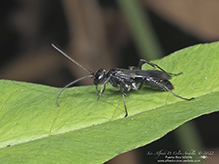 |
|||||
Emily |
|||||
Looking for ID wasp paralyzes jumping spider equal to size and tries to carry it away. |
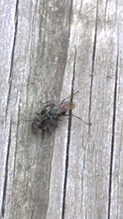 |
||||
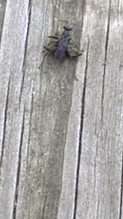 |
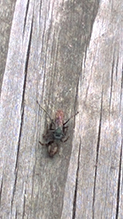 |
||||
MinnesotaSeasons.com Photos |
|||||
|
|||||

Slideshows |
||

Visitor Videos |
|||
Share your video of this insect. |
|||
| This button not working for you? Simply email us at info@MinnesotaSeasons.com. Attach a video, a YouTube link, or a cloud storage link. |
|||
Other Videos |
|||
| Pompilidae (Spider Wasp) Paul Verhulst |
|||
About
Uploaded on Aug 2, 2011 This video is made in my backyard. While we were eating, an spiderwasp (Pompilidae) attacked a spider. In a few seconds he was paralyzed by the venomous sting. (This tragedy happened the first of August (2011). After that i decided to follow the wasp and his prey to his hole. The footage was shot using a iPhone 4. |
|||
| avispa versus araña ( Pompilidae) iati88 |
|||
About
Published on Jan 11, 2015 Filmado en Parque Finky el 10-01-2015. La avispa hembra captura, pica y paraliza a la araña, entonces arrastra a su presa de vuelta a su madriguera o a un nido especialmente preparado, donde un solo huevo se deposita en el abdomen de la araña, posteriormente bloquea la entrada dejandola atrapada. Cuando la larva de la avispa eclosiona, crea un pequeño agujero en el abdomen de la araña, para entrar en él, alimentándose vorazmente, evitando órganos vitales tanto tiempo como le sea posible para mantenerla viva. Después de varias semanas, la larva se convierte en pupa. Finalmente, se convierte en un adulto y emerge del abdomen de la araña. |
|||
| Pompilidae hernando |
|||
About
Published on Jul 18, 2015 avispa Pompilidae haciendo una cueva de cría Google Translate: Pompilidae wasp making a breeding cave |
|||
| Pompilidae and his spider Mark Mile |
|||
About
Published on Feb 1, 2013 i very lucky that i have seen.......!!! |
|||

Visitor Sightings |
|||||
Report a sighting of this insect. |
|||||
| This button not working for you? Simply email us at info@MinnesotaSeasons.com. Be sure to include a location. |
|||||
| DMeulpolder 6/6/2023 |
Location: Golden Valley, MN My Wisteria is covered in these flying insects. They fly like wasps, have metallic blue wings and a dark body with red-orange legs and around the head. At least that’s as much as I got with a quick look. Are they harmful? What can I do to get rid of them? |
||||
| John Valo 6/6/2023 |
Spider wasps prey on spiders. They are not harmful to plants and will not sting humans unless “extremely provoked.” The best course of action may be to leave them alone. |
||||
| Alfredo Colon 8/15/2022 |
Location: Albany, NY |
 |
|||
| Emily 8/29/2015 |
Location: Mound, Mn wasp paralyzes jumping spider equal to size and tries to carry it away. - - - - - - - - - - - - - - - - - - - - - - - - - - - - - - - - - - - - - - - - - - - - - I looked at the UofM and the wasp is a type of Sphecid. |
 |
|||
http://www.extension.umn.edu/garden/insects/find/sphecid-wasps/ - - - - - - - - - - - - - - - - - - - - - - - - - - - - - - - - - - - - - - - - - - - - - It is possible that it is a spider wasp. Which is a different classification than Sphecid. Maybe somebody can help clear it up? I wish I had a better photo than my smart phone could provide. It was moving and hopping around rapidly as it was attempting to carry the spider off. |
|||||
MinnesotaSeasons.com Sightings |
|||||
|
|||||

Created: 10/27/2015
Last Updated:
